Kenya is one of the classic safari destinations and for good reasons. With the presence of the big 5, a plethora of other African animals, and its wildebeest migration, wildlife is usually the main focus. But Kenya has much more to offer and we invite you to discover it with our 9 day itinerary.
Kenya has to be the first country people think of when picturing a safari destination. It is host to numerous parks, reserves, and conservancies, with the Masai Mara being the most renowned. The big 5 can all be found (lions, buffalos, elephants, rhinos, and leopards) and the biannual wildebeest migration, where millions of them cross the Tanzanian border, is another trademark of this reserve. But the same incredible variety and quantity of wildlife can be seen anywhere in Kenya, not just in parks.
With 44 tribes, Kenya’s cultural heritage is also extremely rich. The Maasai tribe, while not the largest, is probably the most emblematic. Its members are famous for their distinctive customs, red dresses, and the bravery of their warriors. The country was also under the colonial influence of the British Empire from 1888 to 1962. This explains why the two official languages are Swahili and English, both largely in use, and adds another interesting layer of cultural complexity and identity.
Lastly, the Kenyan scenery has to be the silent contributor to the overall picture of this safari destination. With a range of savanna hills (Masai Mara), dry dusty stretches of land (Tsavo), drying swamps (Amboseli), expansive lakes (Bogoria, Naivasha, Nakuru, Victoria), towering mounts (Mount Kenya), volcanic activity (Mount Longonot), and deep gorges (Great Valley Rift), Kenya has been gifted with an immense variety of gorgeous landscapes.

Our safari in Kenya was one of our best trips despite having traveled a fair bit! Whilst traveling, childhood memories were re-emerging from books we’d read, movies we’d watched, and even video games we’d played! (Have you ever been chased by wildebeests in The Lion King video game on Sega Genesis/Mega Drive? A stressful but memorable experience for a kid apparently!)
If you intend to go on a Kenyan safari, we hope our itinerary can give you some insights into how to best plan it, so you can live a similar experience.
Day 1 / Nairobi Day Tour

-
Drive around Nairobi
50km (31.1mi) | 2h
David Sheldrick Wildlife Trust Elephant Orphanage
After being picked up by our guide for the day, the very first thing we did was actually paying off our balance for the whole safari which meant a quick trip to heavily guarded “money exchange street” in Nairobi.
After paying our dues, we then headed towards the David Sheldrick Wildlife Trust‘s Elephant orphanage which we wanted to reach for the daily 11am feeding time. The nursery is host to 16 elephants which you can watch drink milk from the bottle and play around with each other in water and mud.
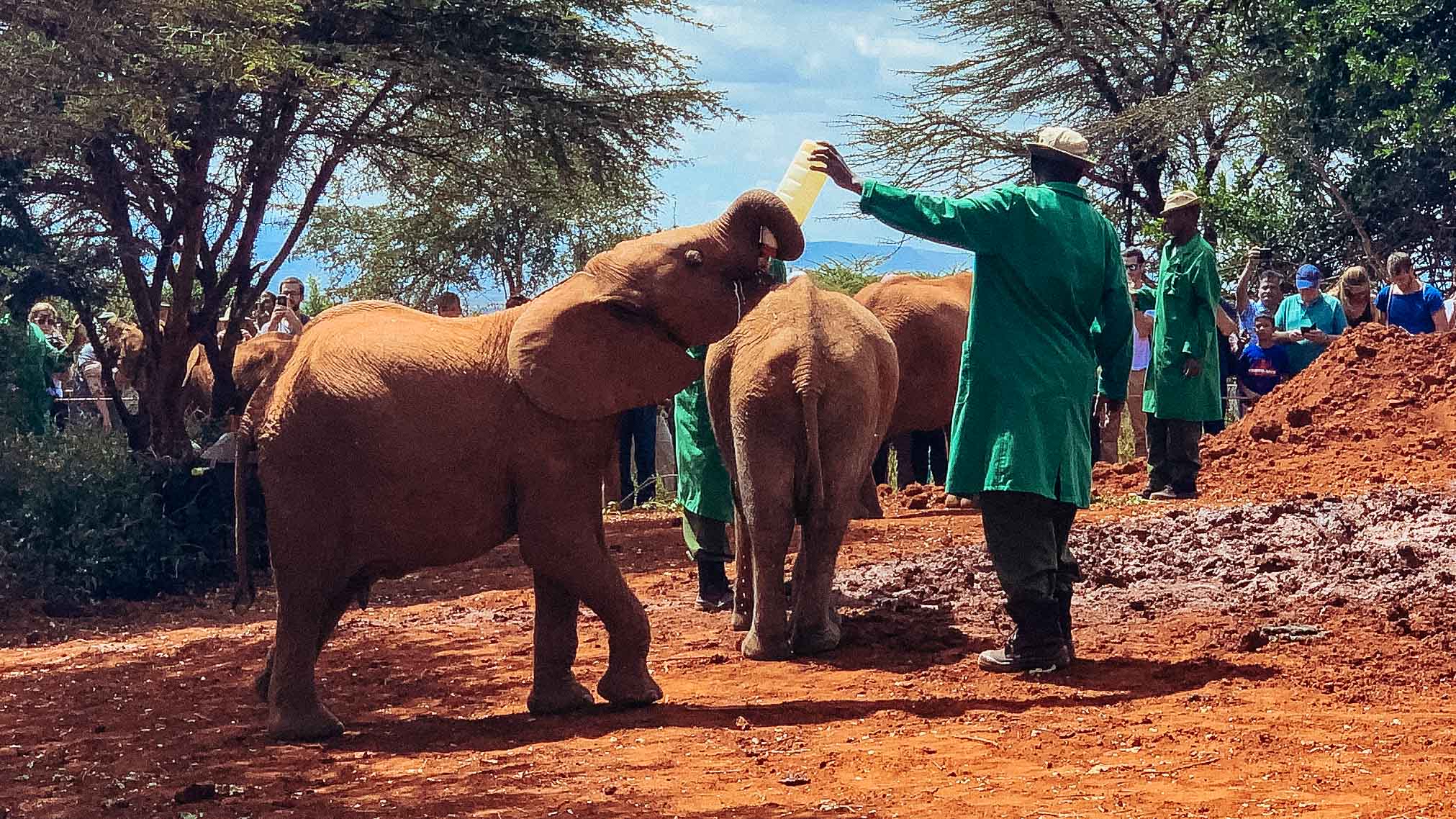
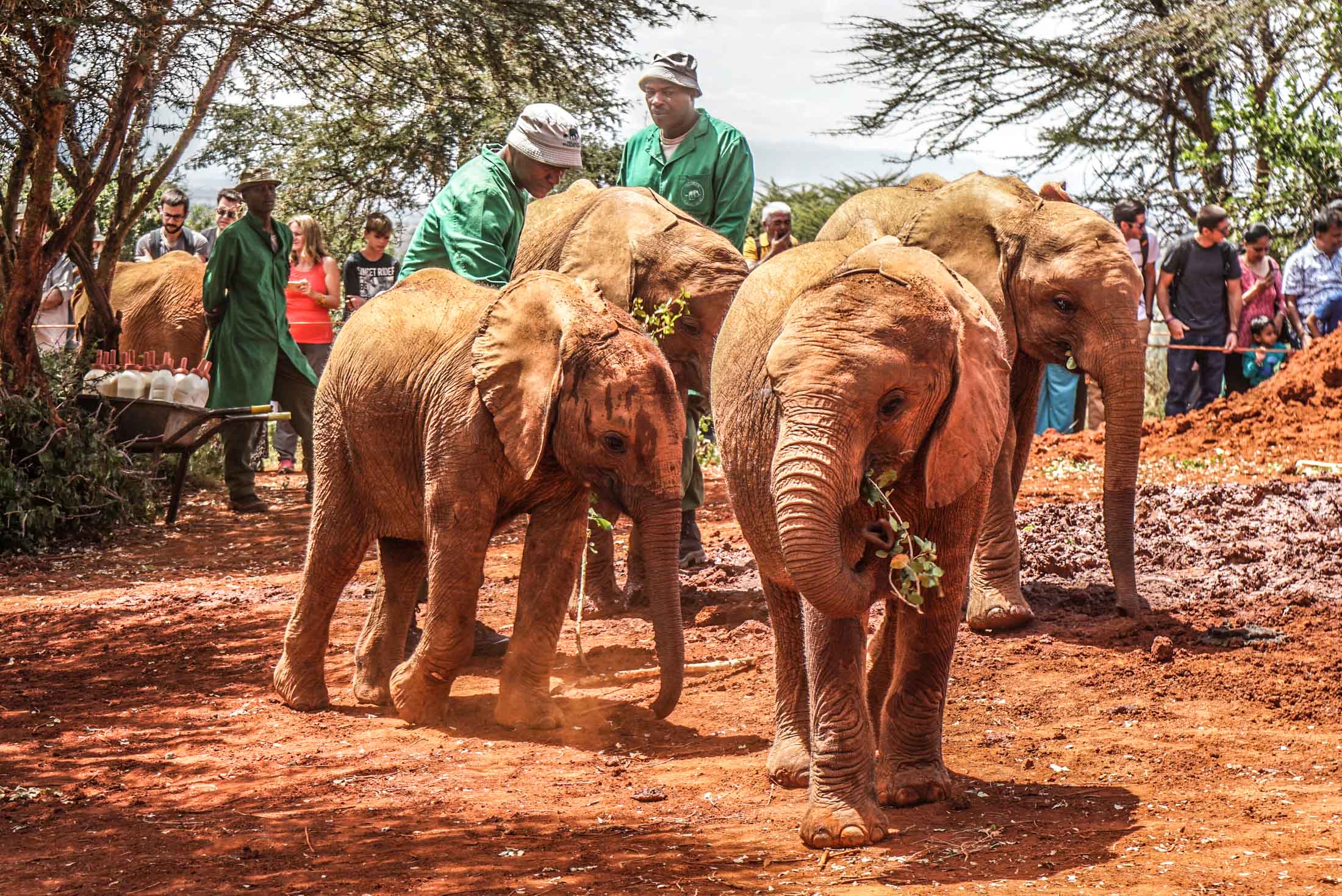
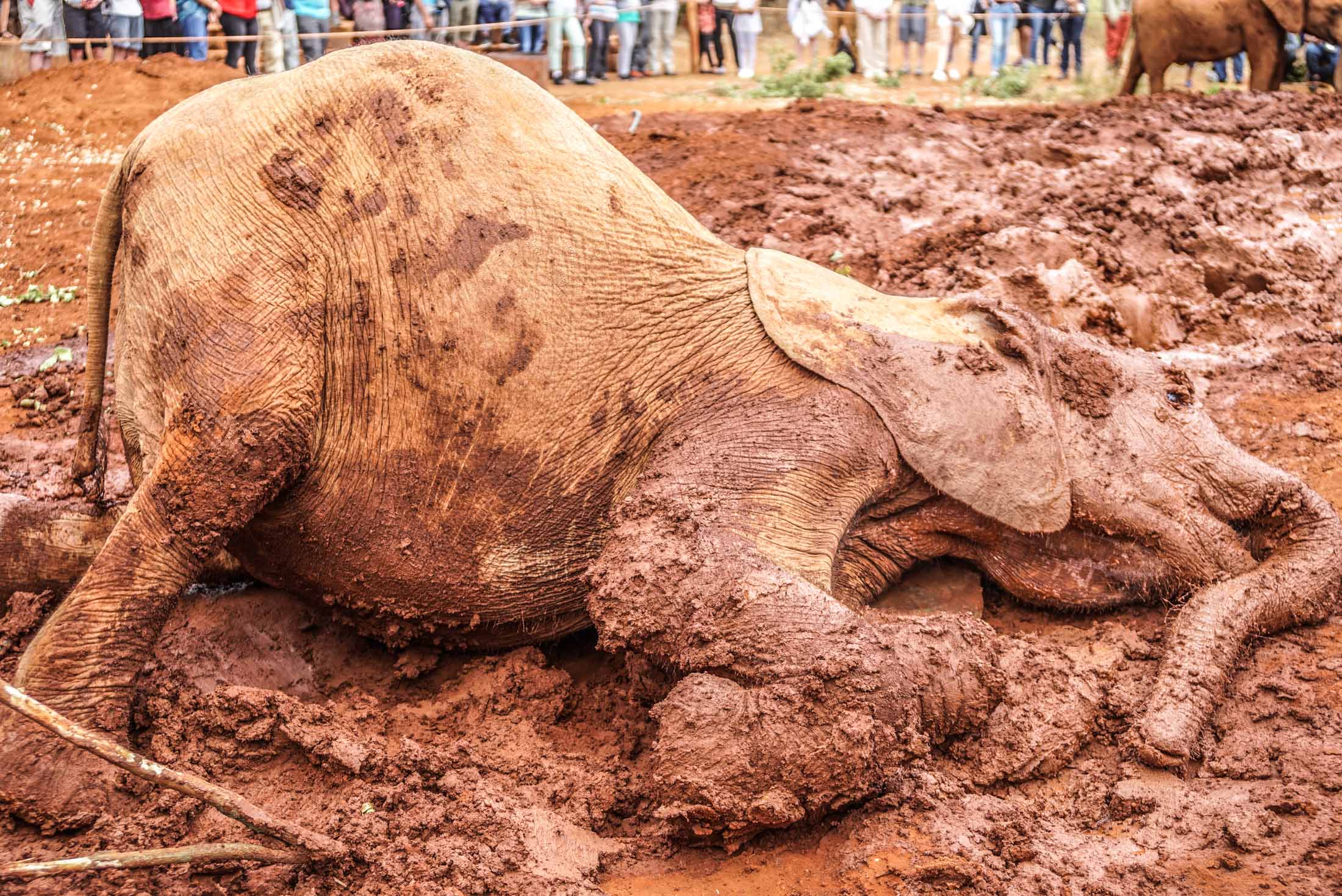
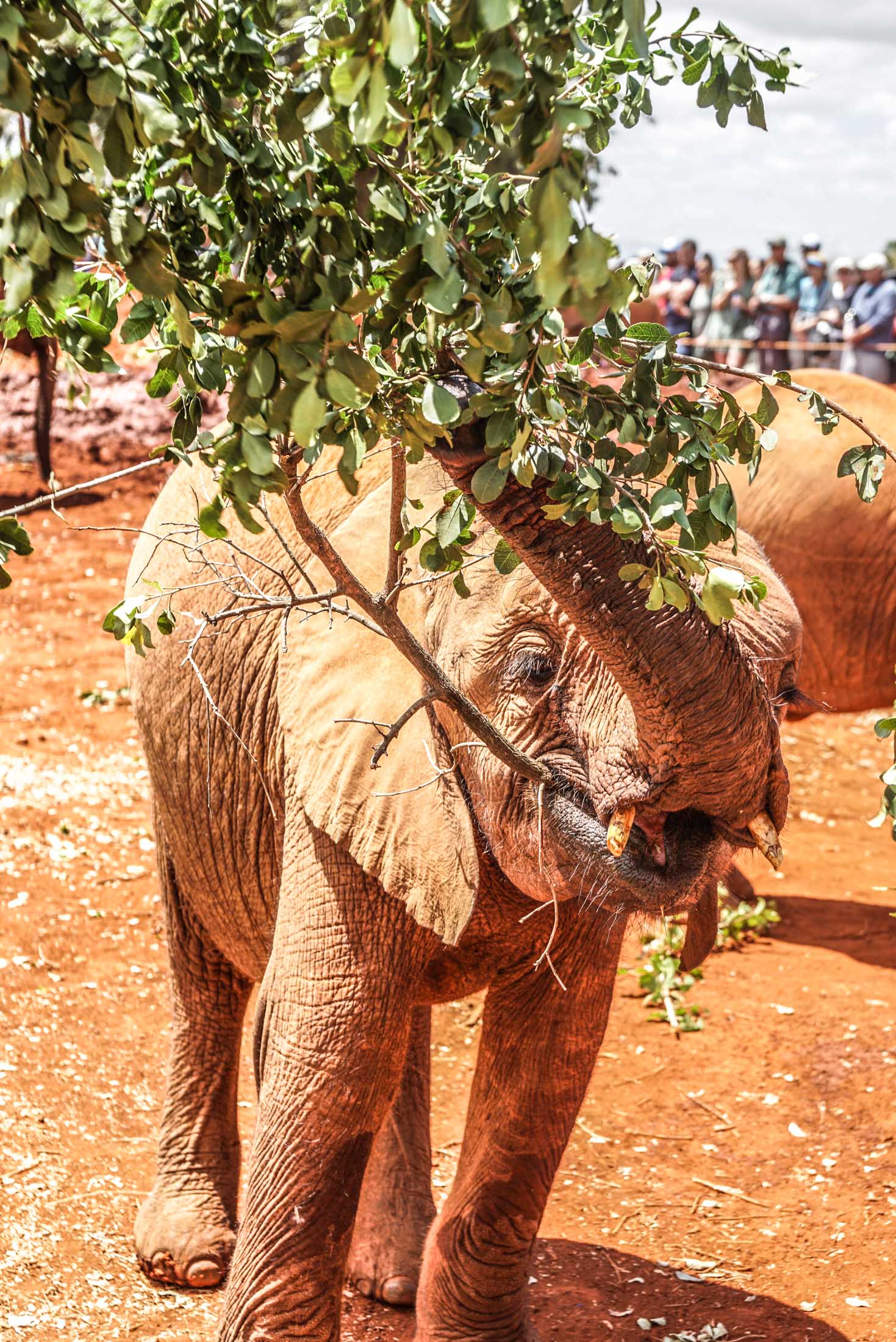
- Opening Hours / Open every day 11am-12pm
- Visit Time / 1h required (+30min waiting prior)
- Cost / Ksh. 500/pers
Giraffe centre
The Giraffe Centre aims to protect and breed the Rothschild’s giraffe, one of the three main giraffe subspecies. It is also an education center so you get to learn about giraffes, their population, and the center’s conservation efforts. Additionally, you get to feed the giraffes and, if you dare, get a kiss by putting the food pellet between your lips. The combination of education and feeding makes it a great family activity.


- Opening Hours / Every day 9am-5pm
- Visit Time / 1h
- Cost / Ksh. 1,500/pers
Viewpoint over Nairobi CBD at Uhuru Park
On our way back towards the city, we made a brief stop at Uhuru Park. On its western side, there is a viewpoint from which you have a vantage point over Nairobi. The park contains an artificial lake and a few national monuments so you can also spend some time wandering around.

- Uhuru Park
- Google Maps
- Opening Hours / Every day 24h (not safe at night)
- Visit Time / As long as you want
- Cost / Free
Cash and Mobile Internet logistics in Nairobi’s CBD
We had planned for some free time in the afternoon and had two main goals: finding a SIM card so we could fill our vital need for Internet access and withdrawing enough cash to cover extra expenses like drinks and tips during our safari. The SIM cards didn’t take long to organize but it took us way more time than we had anticipated to find an ATM not charging us withdrawal fees.
In short, make sure to allow for enough time to get your bearings and organize a few things before you leave for your safari.
Carnivore restaurant
To wrap the day, we opted for the most famous — and very touristy — restaurant in Nairobi. It’s called the Carnivore and is the perfect name for its all-you-can-eat meat buffet which includes lamb, pork, beef, chicken, and more exotic meats like crocodile, ostrich, and camel.

- Opening Hours / Every day 10am-3pm and 6pm-10.30pm
- Visit Time / 1.5h-2h
- Cost / US$28-40/pers + drinks
Where to Stay, Eat & How To Get Around Nairobi
- Mid Range / Best Western Plus Meridian
- Breakfast / Best Western Plus Meridian
- Lunch / Best Western Plus Meridian
- Dinner / Carnivore
- Car / We were on a guided tour with Explorer Kenya.
- Ride Sharing / Uber and Bolt are great options
- Car rental / Or hire a rental car
Day 2-3 / Amboseli National Park

-
Nairobi – Amboseli NP
216km (134.2mi) | 6h including traffic and stops
The following morning we headed to Amboseli National Park, about 6 hours southeast of Nairobi. The park is located just opposite the Tanzanian border and its majestic Kilimanjaro, the highest mountain in Africa and the highest single free-standing mountain in the world.


The scenery was one of the two main reasons we picked this park. The park landscapes are just gorgeous with its swamps, its never-ending vista from the top of Observation Hill (at the Noomotio viewpoint), and the aforementioned Mount Kilimanjaro as a backdrop when the weather conditions are on your side.
The other main reason of our visit was for its resident hordes of elephants who just love refreshing and bathing in the swamps.
But the park is also host to many more animals than “just” elephants.
- Opening Hours / Every day 6am-6pm
- Visit Time / 1-3 days
-
Cost / US$60/pers/24h
+ Ksh. 300 or Ksh. 1,030 per vehicle (under 6 seats vs 6-12 seats)
Consult all park fees
Where to Stay, Eat & How To Get Around Amboseli National Park
- Mid Range / Kibo Safari Camp
- Breakfast / Kibo Safari Camp
- Lunch / Kibo Safari Camp
- Dinner / Kibo Safari Camp
- 4WD / Toyota Land Cruiser with a guide from Explorer Kenya
Day 4 / Drive to Naivasha

-
Amboseli NP – Naivasha
333km (206.9mi) | 8h including traffic and stops
We left Amboseli early in the morning for Naivasha, our next destination. It took roughly 8 hours in total because of the heavy traffic around Nairobi. We drove through a mountainous area west of Nairobi which overlooks the Great Rift valley and offers expansive views.

Once in Naivasha, we were meant to get lunch, then head out for an afternoon walk with animals and sunset boat trip on Lake Naivasha but the rain decided to show up. Not being very excited at the prospect of getting drenched and with Guilly not feeling 100% (something we ate didn’t agree with him), we took our guide’s recommendation to postpone for a sunrise boat trip instead. That meant a big day ahead!
Where to Stay, Eat & How To Get Around Naivasha
- Budget / Panorama Hotel
- Breakfast / Panorama Hotel
- Lunch / Panorama Hotel
- Dinner / Panorama Hotel
- 4WD / Toyota Land Cruiser with a guide from Explorer Kenya
Day 5 / Lake Naivasha boat trip, Crescent Island walk, Hell’s Gate NP bike ride, Ol Njorowa Gorge walk & Lake Nakuru NP
This was a long title! But it also was a pretty full-on day! Surprisingly, the schedule mostly worked out despite being a bit rushed at times.

-
Naivasha lake boat ride
3km (1.9mi) | 1h -
Sanctuary Farm walk
1km (0.6mi) | 1h -
Naivasha – Lake Naivasha-Hell’s Gate NP
34km (21.1mi) | 1h -
Elsa Gate – Ol Njorowa Ranger’s hut
8km (5.1mi) | 1h -
Ol Njorowa Gorge
2km (1.4mi) | 1h -
Hell’s Gate NP – Nakuru NP
104km (64.6mi) | 2h40min
Boat trip on Lake Naivasha
As planned, we woke up to watch the sunrise over the lake. Unfortunately, we had to watch it from the shore after some communication breakdown and ensuing delays. It was still very pretty with the mist over the lake, herons sifting through mud, fishermen throwing nets in the distance and the kind of silence you can only get when being up this early.

The boat trip was awesome. We expected to see hippos in the lake and we were not disappointed with entire families wallowing in water and napping over each other’s back.
Observing the fishermen cast their nets was also of interest. Considering hippos are dangerous and very aggressive (they kill about 500 people a year), it’s insane to think that those men have no choice but to risk their lives daily to make a living. Our guide informed us that there is an average of 3 deaths by hippos each month in this lake alone. A few quick searches online seemed to confirm those numbers including a couple of unlucky tourists once in a while (roughly once a year).
Although our main interest was the hippos, we also got to see defassa waterbucks and a lot of cool birdlife including herons, egrets, cormorants, sea eagles, pelicans, yellow-billed storks, and huge marabou storks (they have one of the widest wingspans of all birds).
- Lake Naivasha boat trips
- Google Maps
- Opening Hours / Every day from sunrise to sunset
- Visit Time / 1h
- Cost / Ksh. 1,500-4,000/pers + tip (varies greatly from operator to operator so shop around; you should get a cheaper price through your guide too)
Walk around “Crescent Island”
Once we reached the end of our boat trip, we were handed over to another guide for a “walk on Crescent Island”. Well, that’s what we signed up for anyway, but ended up walking in a nearby private property called Sanctuary Farm instead. Not having been there, we therefore can’t comment on what Crescent Island is like, but we were not disappointed with our walk at Sanctuary Farm.
One of the downsides of the most famous safari parks is that you need to remain in your vehicle at all times, as there could be dangerous animals nearby. Coming to the Naivasha area, you are able to walk among wildlife because there are no big cats. And that’s exactly what we did. We saw so many wildebeests, gazelles, impalas, waterbucks, zebras, and giraffes. Baby zebras and giraffes are the cutest!
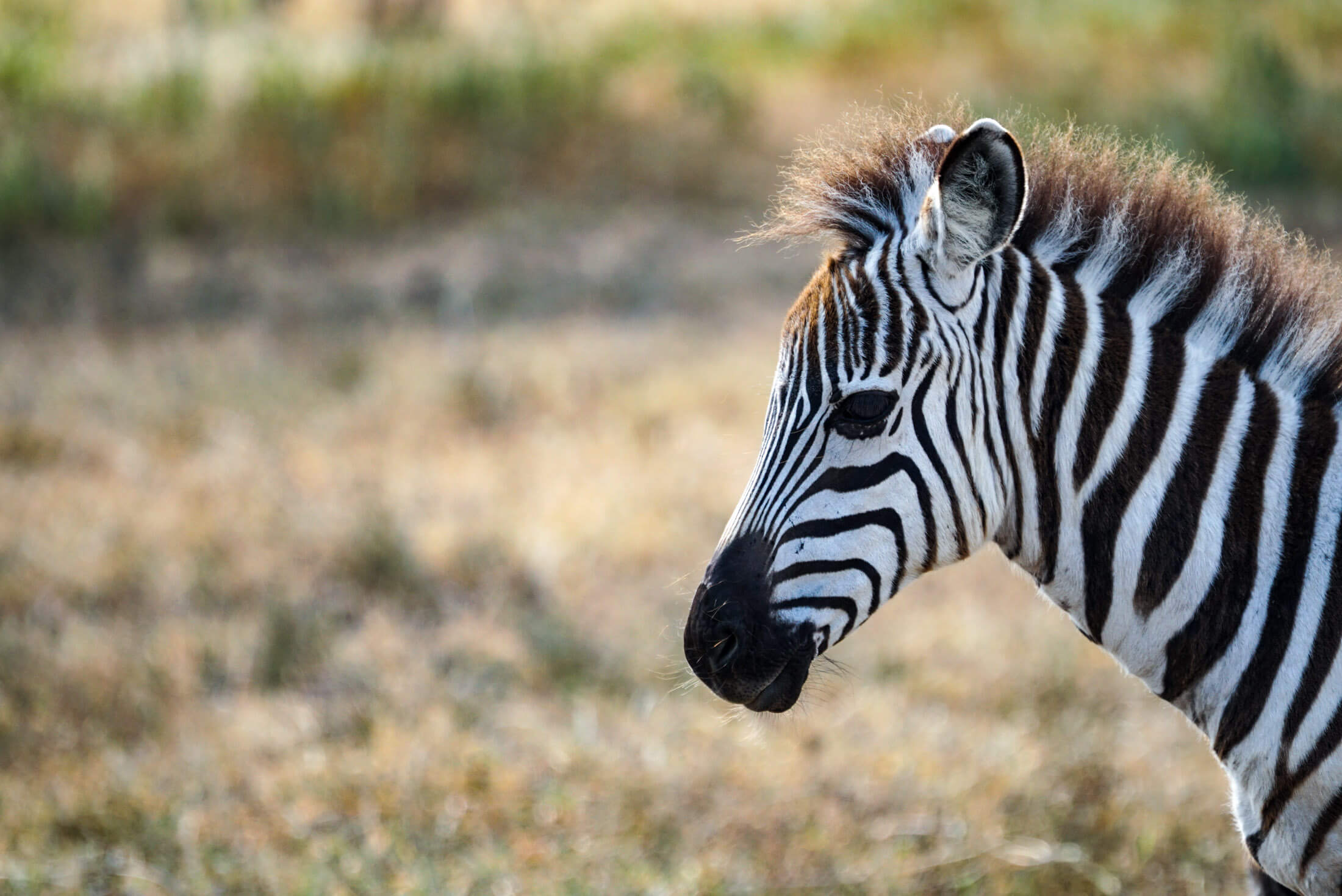
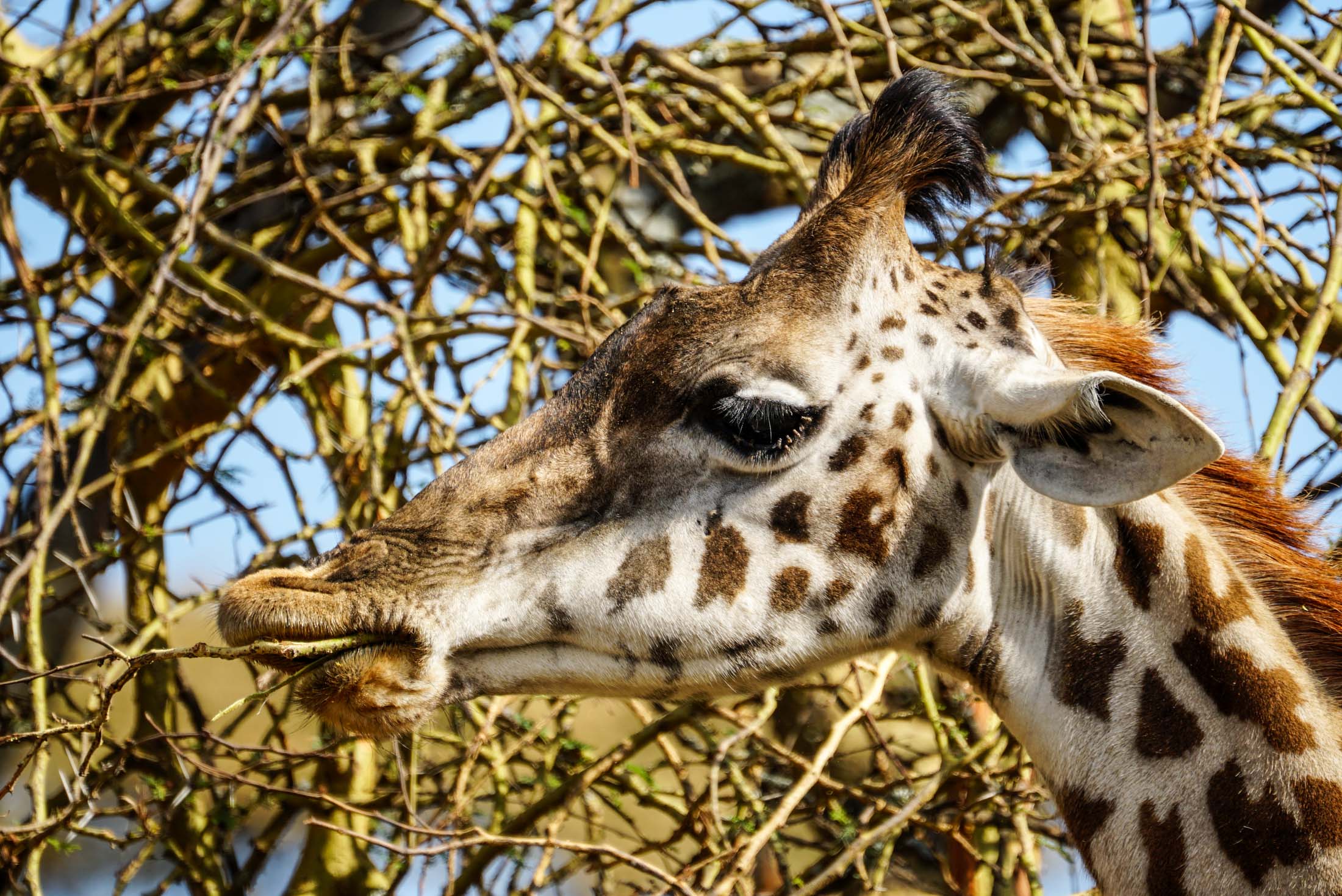
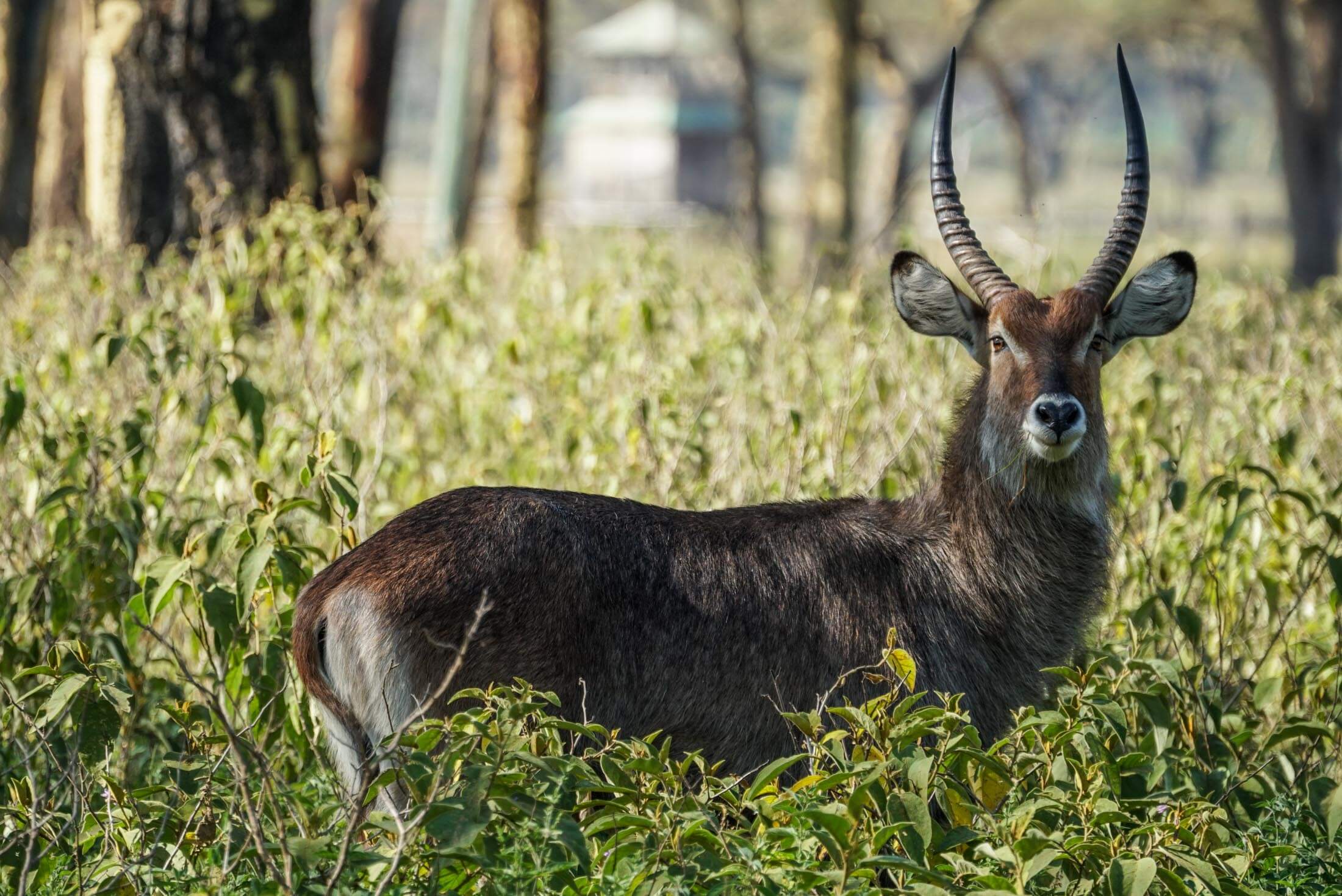
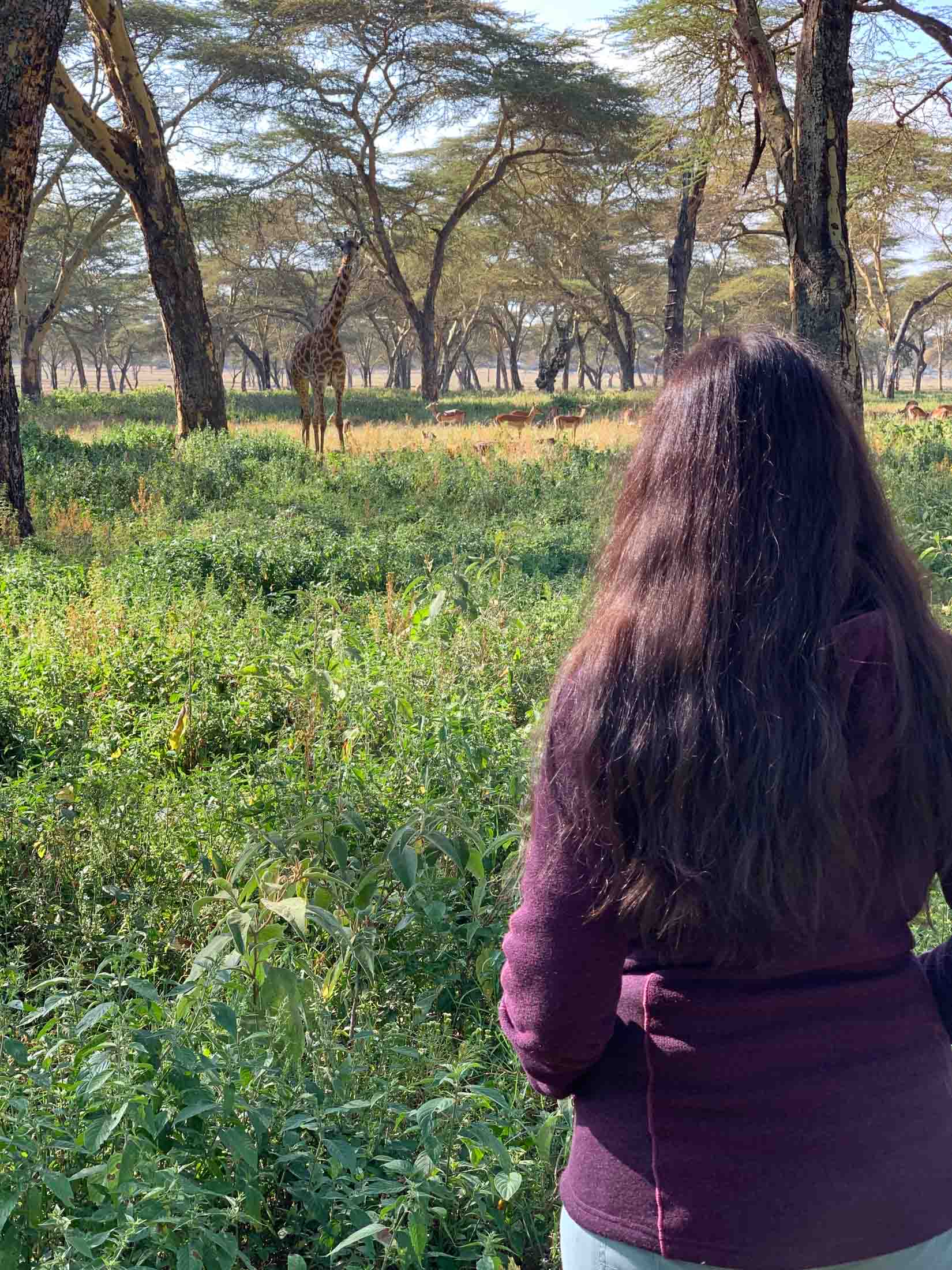
- Opening Hours / Every day from sunrise to sunset (or later if you stay there)
- Visit Time / 1h 15min
- Cost / Unknown + tip for the guide
Bicycle riding in Hell’s Gate National Park
In a similar vein to Crescent Island, head to Hell’s Gate National Park only a few kilometers away from the lake, rent a mountain bike and ride among wildlife.
On top of the animals we had just seen, we saw warthogs, helmeted guinea fowls, and buffalos. Surprisingly, the peaceful-looking buffalos can be bad-tempered and are therefore the only animals you need to pay attention to safety-wise.
Being part of the African Great Rift Valley, the scenery is stunning with towering cliffs and gorges, rock towers you can climb, and geothermal smoke activity in the background (which is used for generating energy). No wonder why the park setting and its environment largely inspired the Lion King movie.
We only crossed the park from one end to the other (it’s not huge) on the main track, but there seemed to be much more to the park than what we’ve seen. If you’re not in a rush like we were, you could easily spend half a day to a day there.
- Opening Hours / Every day 6am-6pm
- Visit Time / 1h-1 day
-
Cost / US$26/pers/24h
+ Ksh. 300 or Ksh. 1,030 per vehicle (under 6 seats vs 6-12 seats)
Consult all park fees - Distance / 8.2km of cycling (Elsa Gate-Ol Njorowa Ranger’s hut)
Walk in the Ol Njorowa Gorge
The gorge is conveniently located on the other side of Hell’s Gate National Park so we only had to ride another 200 meters on the road before reaching it, which marked the end of our ride too. We were then assigned one of the local Masai guides, a man in his 50’s or 60’s who turned out to be surprisingly agile and swift when it came to trek in treacherous and slippery conditions. (At least that’s how it felt to us! OK maybe it was not that bad.)
The gorge is very pretty and partly renowned thanks to a few movies filmed there, the most famous being Tomb Raider: Cradle of Life. Its geothermal features also make it of interest with burning hot water seeping in places through its sidewalls. The way to tell if it was hot before burning your finger, was to look for dark green moss around the stream.
Being on a schedule and with such a big day, we had to rush through the gorge and take a few shortcuts. We wish we had had more time to really explore the gorge or at least take our time, but it was still an enjoyable experience.
Unfortunately, the gorge is indefinitely closed due to flash floods which happened the day after we visited (we were there on the 1st of September 2019) and took seven lives! We later learned that such an accident had already happened in 2012 with the same number of fatalities. It was reopened after a while and no accident had happened since. Flash floods are very difficult to predict as it does not have to rain in the area for them to happen. The park administration seemed to be hoping to reopen in early 2020 after putting in place extra safety measures (the Hell’s Gate NP visits had dropped by 30% since) but it has yet to happen as of June 2020. Unless, you go with a guide… I have read a few recent reviews and even some blog article suggesting some tourists could visit it (some only from the top edge, some as per normal).
As for ourselves, we count ourselves lucky as it could easily have been us, had we organized our safari itinerary any differently!
- Opening Hours / Closed indefinitely (sort of)
- Visit Time / 1h-1h 30min
- Cost / Unknown + tip (+ cost of entry to Hell’s Gate NP)
Lake Nakuru National Park

As the name indicates, the Lake Nakuru National Park‘s main natural feature is its lake. It isn’t very difficult to navigate as tracks essentially circle it. There are numerous standing dead trees on the lake edge which creates an eerie atmosphere in places. It’s especially true where the, now flooded and abandoned, old park gates are located which is very picturesque. There are a few hilly sectors, especially west of the lake, affording extensive views over the whole area. At the Baboon Cliff viewpoint, we bumped, not into monkeys, but rock hyraxes which are cute rodents resembling marmots.


The lake used to be home to millions of flamingos but a large increase of the water level in 2013 caused them to migrate to Lake Bogoria instead. There are still some, but we did see more in Amboseli when we were there (August-September). Flamingos aren’t the only bird to call lake Nakuru home.

We were aware of the lack of flamingos so were not disappointed. The main reason we had Nakuru on our itinerary was for its rhinos! There was only a slim chance we could see them in other parks, so Nakuru was a good complement. Moreover, the park is host to both white and black rhinos, the latter being even rarer and currently critically endangered. We managed to see a few white rhinos from afar (as well as a leopard) but unfortunately only got a glimpse of the elusive black rhino.
There is a section on the East side of the lake (at least when we were there) where the track was overrun with baboons. They are always good fun to observe!

- Opening Hours / Every day 6am-6pm
- Visit Time / 1-2 days
-
Cost / US$60/pers/24h
+ Ksh. 300 or Ksh. 1,030 per vehicle (under 6 seats vs 6-12 seats)
Consult all park fees
Where to Stay, Eat & How To Get Around Nakuru
- Mid Range / Flamingo Hill Tented Camp
- Breakfast / Flamingo Hill Tented Camp
- Lunch / Flamingo Hill Tented Camp
- Dinner / Flamingo Hill Tented Camp
- 4WD / Toyota Land Cruiser with a guide from Explorer Kenya
- Boat / Can be organized directly at the lake. We had pre-organized via Explorer Kenya.
- Mountain Bike / Can be organized at the corner leading to the entrance of Hell’s Gate NP. We had pre-organized via Explorer Kenya.
Day 6-9 / Masai Mara National Reserve

-
Nakuru – Masai Marai
205km (127.4mi) | 5h -
Around the Masai Mara
280km (174.0mi) | Over 3 days -
Masai Mara – Nairobi
240km (149.1mi) | 5h
The Masai Mara National Reserve (affectionately called the Mara) is the figurehead of Kenyan safari parks and one of the most renowned in the world. It directly faces the Serengenti National Park across the Tanzanian border, another worldwide famous national park, to form a unique ecosystem of rivers and gently rolling savanna hills.

Its most famous river is the Mara river where we could admire thousands of wildebeests crossing the river as part of their biannual migration between Kenya and Tanzania. Hippos were quietly minding their own business whilst some of the wildebeests could not make it to the other side due to resident crocodiles. This is an extraordinary natural phenomenon to witness and unique to this part of Africa.

The park is also known for being host to the big 5: leopards, buffalos, rhinos, elephants, and the “Lion King”, the latter being present in the highest density in the world.
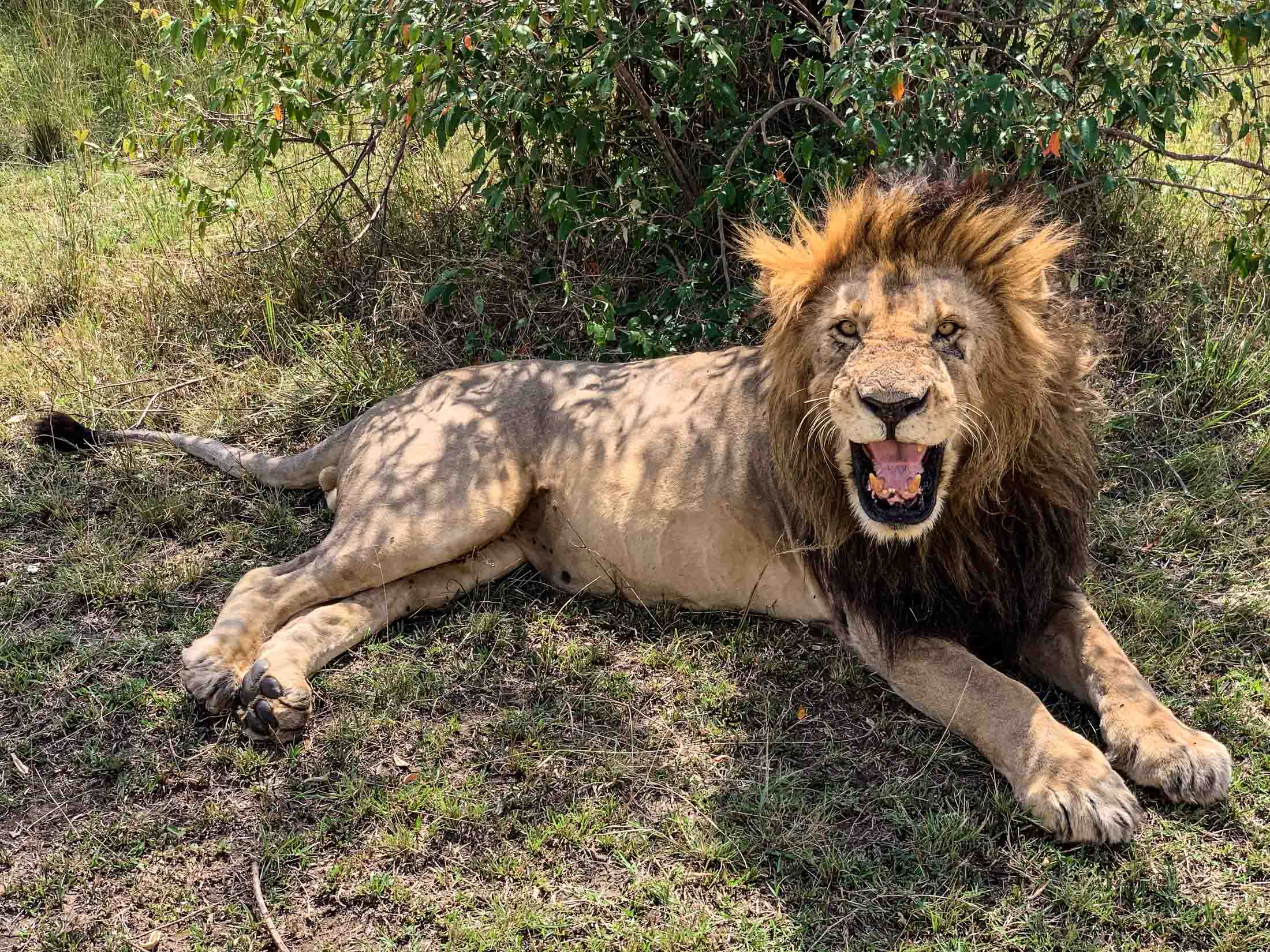
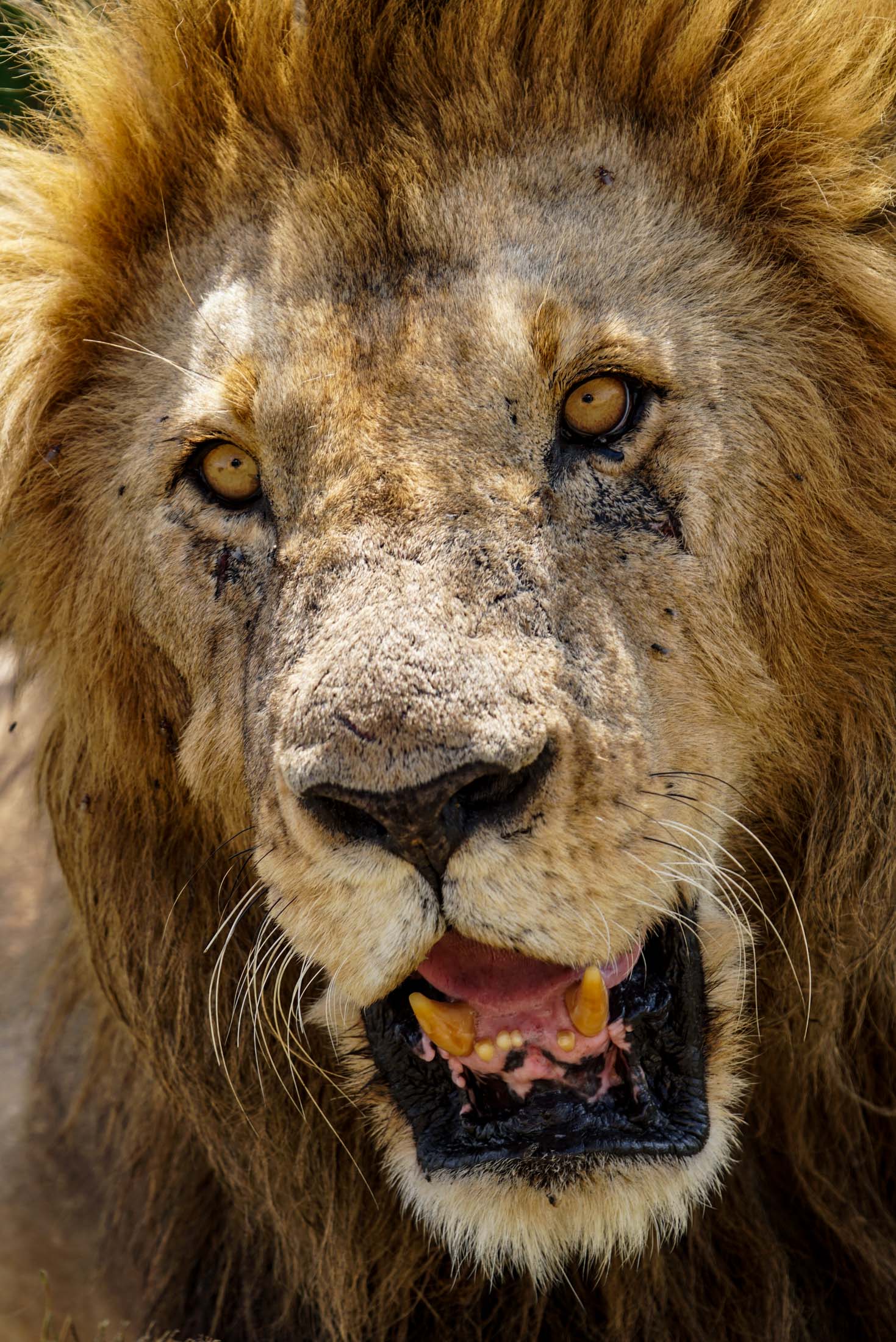
Other predators such as hyenas and cheetahs are frequent sights attracted by the high concentration in game such as wildebeests, zebras, impalas, giraffes (of the Masai subspecies), gazelles, warthogs and so many more!


- Masai Mara National Reserve
- Google Maps
- Opening Hours / Every day 6.30am-6.30pm
- Visit Time / 3-4 days
-
Cost /
US$70/pers/24h ($40 for under 12) if sleeping inside park
US$80/pers/24h ($45 for under 12) if sleeping outside park
+ Ksh. 400 or Ksh. 1,000 per vehicle (under 6 seats vs 6-12 seats)
Consult all park fees
It is possible to visit a local Maasai village for a fee. A local guide is assigned to you and the villagers all gather to perform a traditional welcome song and dance for you in traditional costumes. A few more songs and dances are interpreted by various members of the tribe and you finally take part in their customary jumping contest (adamu) which is a lot of fun and determines who will attract a bride (Guilly probably would have remained single!) during the Eunoto celebration (junior warriors becoming seniors). Lastly, you get to visit the village and its mud houses, see how they live, learn about their customs and history, and finish in their local craft market, perfect if you’d like extra souvenirs.
- Maasai village visit
- Opening Hours / Every day
- Visit Time / 1h-1h 30min
- Cost / Ksh. 2,000/pers + tip
Where to Stay, Eat & How To Get Around Masai Mara
- Mid Range / Mara Eden Safari Camp (2 nights)
- Mid Range / Mara Sopa Lodge (1 night)
- Breakfast / Mara Eden Safari Camp
- Lunch / Mara Eden Safari Camp
- Dinner / Mara Eden Safari Camp
- 4WD / Toyota Land Cruiser with a guide from Explorer Kenya
If you have 12, 15, 17 or more days in Kenya
If you have 12 days in Kenya
- Add a day in Nairobi to cover the Karen Blixen Museum, the National Museum, the Nairobi National Park, and a guided visit of the Kibera slum (if it appeals to you). All these are described in our article about the best 10 places to visit in Nairobi.
- Add a day in the Naivasha area. Mount Longonot is a dormant volcano that can be hiked and isn’t very far from Naivasha. The extra day will also allow you to take your time in Hell’s Gate National Park.
- Add a day in Nakuru. We felt that we could have benefitted from more time to enjoy the area and have better chances of spotting the black and white rhinos.
If you have 15 days in Kenya
- Invert our itinerary by starting with Naivasha then onto Nakuru, Masai Mara, and finally Amboseli. You could then pursue east and:
- Spend 3 days in the West and East Tsavo National Parks
- Spend 3 days relaxing by the beach in Mombasa and fly back from there
- Alternatively, you could follow in our footsteps and fly from Nairobi to Zanzibar then:
- Spend 2 days in Stone Town
- Spend 2 days in Nungwi
- Spend 2 days in Paje
If you have 17 days in Kenya and Tanzania
- Add 8 days to:
- cross over to Tanzania from Amboseli NP
- cover the Arusha National Park,
- Tarangire National Park,
- Lake Manyara National Park,
- Ngorongoro Crater,
- Serengeti National Park,
- and finally, cross back to Kenya close to Masai Mara
We could offer you a thousand more itineraries with possible combinations but here are some parks or activities for you to consider in your itinerary instead:
- The Aberdare NP
- The Samburu NP
- Lake Bogoria
- Climb the Kilimanjaro (from five to nine days to complete)
- A gorilla trek in Uganda
Apologies for the very long list, but it’s very difficult to limit yourself when you’ve had such a memorable trip!
Animals
- French kissing a giraffe
- Elephants going bathing in the morning in Amboseli’s swamps
- Family of 4 cheetahs just outside the Amboseli NP gates (rare, they’re not social animals)
- Thousands of wildebeests crossing the Mara river
- Seeing the Lion King from two meters away
- Seeing a leopard
- Seeing lions cubs
- Finding out about dik-diks! They look adorable!


Scenery
- Sunset in Amboseli
- Sunrise on Lake Naivasha
- Sunrise in the Mara
- Gorgeous swamps of Amboseli
- Vista from Observatory Hill in Amboseli
- The clear view on the Kilimanjaro with a giraffe and a Masai in the foreground as we were leaving Amboseli
- The Great Rift Valley in Hell’s Gate NP
People
- Bumping into traditionally dressed Maasais when tracking giraffes in the bush, attempting to communicate only with body language and exchanging handshakes
- All the Maasais ladies trying to sell souvenirs to cars queuing at the entrance of Amboseli and the Mara
- Fisherman casting nets in Lake Naivasha with water up to their hips and hippos nearby
- Jumping contest at the Masai village
- Crossing through some poor and muddy villages in the mountainous, cold and foggy area between Nakuru and the Mara
- The crazy driving!
- Accidents on the side of the road
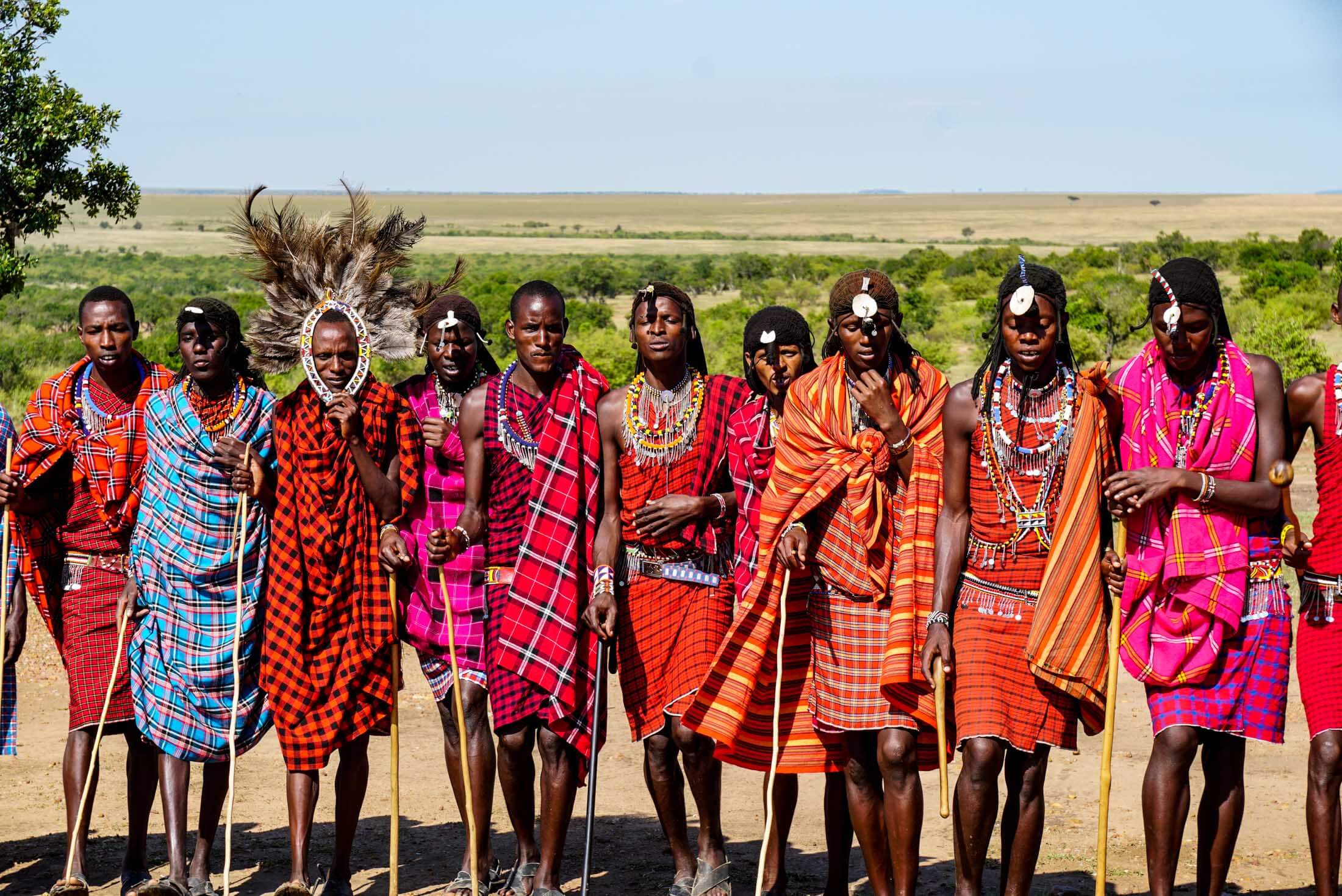

Activities
- Mountain biking with warthogs and zebras in gorgeous landscapes
- Hiking/climbing bare feet in the Ol Njorowa gorge
- Boat trip with hippos
Accommodation
- Loved the safari vibes of the gorgeous tented camps of Kibo Safari Camp, Flamingo Hill Tented Camp and Mara Eden Camp that we stayed at in Amboseli, Nakuru, and Masai Mara (generally, we preferred tented camps over hotels and lodges)
- LOVED the scenery next to the Mara Eden Camp with plenty of hippos and HUGE crocodiles just meters away from our tent!

First of all, you need to understand that many factors can influence the cost of a safari. Here were our choices so you can compare costs properly.
Our safari choices
Itinerary
- 4 parks (Masai Mara, Amboseli, Nakuru, Hell’s gate)
- 4 extra activities (boat trip, animal sanctuary walk, cycling, Masai village visit)
- 1 day guided visit of Nairobi
Accommodation
- Standards ranging from “budget” to “mid-range” (mostly mid-range)
- Both inside and outside of the parks depending on the park or night
Guide
- 1 combined guide/driver
- Very experienced guide
- English speaking (cheaper than French)
Transport
- Private 4WD
- Access to the parks by road (cheaper as opposed to flying in)
Safari company
- Very reputable local safari company; Explorer Kenya was #1 on TripAdvisor when we did our research
Other factors
- High season (August)
Safari budget breakdown
It’s difficult to provide an exact breakdown of all costs as most accommodation, food, transport, and activities were included in our safari package. Only a few expenses before and after the safari were separate. They provided little insights, so we preferred to include them in the package so they could be averaged per day.

If the final amounts scare you, don’t worry, they still scare us too! Although, not all safaris have to be expensive. However, we treated our first safari as a once in a lifetime experience and didn’t want to cheap out to enjoy it fully. Next time (hopefully) might be different!
Cost of insurance and flights have not been included as they will vary largely depending on your travel circumstances (i.e. trip duration, period, and origin). Check out this link if you’d like to know how much the flight to Nairobi would cost you.
- Currency / Kenyan Shillings (KES), US dollars are also widely accepted in the tourism industry
- Language(s) / Swahili and English
- Driving side / Left
The best time to visit Kenya is during the dry season from late June to October for better weather and for chances to see the wildebeest migration. It is still feasible in the wet season but will require a 4WD. Not all tracks and rivers will be passable.
- Jambo / Hello. You’ll hear it a lot!
- Assante / Thank you.
- Karibu / Welcome.
- Hakuna Matata / No worries
- Simba / Lion
- Mufasa / King
- Pumbaa / Slow witted
- Timon / Respect
- Nala / Gift
- Rafiki / Friend
- Zazu / Movement
If you haven’t worked it out yet, the Lion King character names are all Swahili words!
SIM card / We have used Safaricom which worked even in remote areas within safari parks
Money exchange / Avoid airports and hotels if you can, they have terrible exchange rates. Ask your guide for the best money exchange if you have one. There are numerous money changers in Nairobi otherwise, just don’t change any money on the street, it’s illegal and you’ll probably get scammed.
Corruption / Unfortunately, corrupt police in Kenya seems to be widespread. Being driven by a guide, we haven’t had to face it ourselves, but it is a widely known fact. If you do get asked for a bribe, refuse to pay it. If you are not let go, then have your embassy phone number handy and warn to call them, it should hopefully do the trick. Paying bribes only perpetuates the problem.
Maasai photos / It’s generally advised to ask before taking photos of people. It’s especially true for Maasais as they will apparently throw stones at your vehicle if you do! We haven’t tried to verify our guide’s theory.
- From North America / You can fly from New York (JFK) directly into Nairobi (NBO)
- From Europe / There are direct flights to Nairobi from London, Paris, Amsterdam, Frankfurt, Geneva, Zürich, Rome, and Istanbul.
- From Australia / There are no direct flights to Nairobi from any city in Australia. Your best bets to connect will be flying through Dubai or Johannesburg.
Your two main options will be to either hire the service of a guide or to self-drive. Although, renting a car is also possible if you are brave enough.
Before you leave on any trip, whether it is for a weekend or multiple months, it’s crucial you get travel insurance. It always baffles us when we meet oblivious travelers who believe they are invincible and travel without insurance. These are usually the same people who will ride motorcycles without a helmet (because not wearing one in countries with higher road fatalities makes total sense…)
Medical costs overseas can add up very quickly especially if you require hospitalization let alone evacuation. Worst comes to worst, body repatriation costs aren’t the best parting gift for your relatives either.
If you need to cancel or shorten your trip for health, business, or personal reasons (e.g. death of a close relative), your insurance can cover the costs too.
Lastly, travel plans seem to change constantly. If your flight gets canceled or delayed, if your baggage gets lost, if a coronavirus pandemic cancels all of your travel plans, you’ll be glad you took insurance to cover for these unforeseen circumstances!
We know it sometimes feels like an unnecessary expense and it is until you suddenly require to pay thousands of dollars for an illness or injury. It really is a small cost to pay for peace of mind.
Make sure to bookmark and share the article with your friends and family on social media if you’ve found it useful.
If you have questions about our itinerary or want to share about your own, head to the comments below




































![✨Where will you go next when you can travel again?
[version 🇫🇷 en bas⬇️]
.
.
🇦🇺 Never stop exploring 🇦🇺
We’ve been good at sharing daily stories of our trip but not so great at sharing photos and sharing posts, so we’ve about to catch-up on the last few months on the road with La Banana!
.
.
We’ve crossed the South of France and North of Italy, explored Slovenia and Croatia and today we are in Montenegro! But first things first, we’re taking you in France where it all started!
.
And who’s never dreamt of traveling to France?! There is so much to explore that you could easily spend a year traveling in our beautiful home country!
.
.
En route!
.
.
🇫🇷 Explorer le monde 🇫🇷
On s’amuse bien à partager nos stories tous les jours, mais on a pas était top a partager des photos et posts tout au long de notre voyage, alors voila on va catch-up sur les derniers mois sur la route avec La Banana!
.
.
Nous avons traversé le sud de la France, le nord de l’Italie, avons exploré La Slovénie et la Croatie et aujourd’hui nous sommes au Montenegro!
.
.
Alors revenons en arrière la où tout à commencé, notre douce France! Qui n’a jamais rêvé d’explorer en long et large notre beau pays? Il y a tellement à faire que meme sur un voyage d’un an il y aurait toujours tant à découvrir! Ici ça n’est qu’un aperçu!
.
.
En route!
.
.
✨Mais vous, oú irez-vous voyager dès que vous le pourrez?](https://nomadsfix.com/wp-content/plugins/instagram-feed/img/placeholder.png)
 by Guillaume Debever and Bénédicte Bouchereau. All rights reserved.
by Guillaume Debever and Bénédicte Bouchereau. All rights reserved.